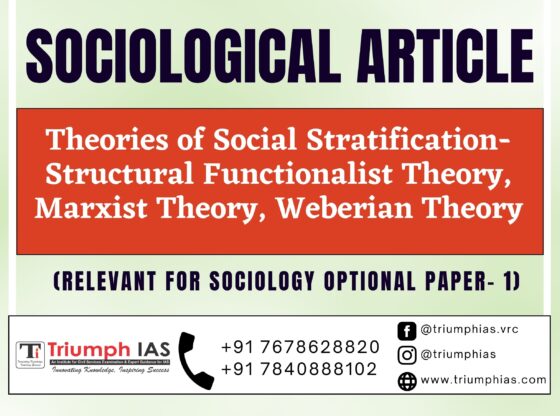Theories of Social Stratification- Structural Functionalist Theory, Marxist Theory, Weberian Theory
Relevant for sociology optional Paper- 1 (Unit- 5 : Sociology- Stratification & Mobility)

Social stratification refers to the categorization of people into different classes based on various factors such as income, wealth, education, occupation, and social status. It is a pervasive phenomenon in all societies and plays a critical role in shaping the opportunities, experiences, and life chances of individuals. Theories of social stratification seek to explain how and why societies are structured into hierarchical layers, the dynamics of the processes involved, and the consequences of stratification for individuals and society as a whole. This essay will discuss three major theories of social stratification: Structural Functionalist Theory, Marxist Theory, and Weberian Theory.
Structural Functionalist Theory is one of the most influential theories of social stratification. According to this theory, social stratification is necessary and inevitable because it serves vital functions in society. One of the key functions is to ensure that the most talented and skilled individuals occupy the most important positions in society. This ensures that society is run efficiently, and its resources are allocated effectively. Social stratification also provides a sense of social order and stability, as individuals know their place in society and what is expected of them.
Structural Functionalist Theory views social stratification as a meritocracy, where individuals are rewarded based on their talent, effort, and ability. This means that those who work harder and are more capable are more likely to achieve success and climb the social ladder. This theory also emphasizes that social mobility is possible and that individuals can move up or down the social ladder based on their merit.
However, Structural Functionalist Theory has been criticized for ignoring the role of power and privilege in social stratification. It assumes that everyone has equal opportunities to succeed, which is not always the case in reality. Additionally, this theory does not address how social stratification creates inequality and perpetuates social divisions.
Marxist Theory is another influential theory of social stratification. According to this theory, social stratification is a product of the capitalist system. Marx argued that the bourgeoisie, who own the means of production, exploit the proletariat, who do not own any means of production and are forced to sell their labor for a wage. This results in a class struggle between the two classes, as the bourgeoisie seek to maximize their profits at the expense of the proletariat.
Marxist Theory views social stratification as a result of economic inequality and the concentration of power and wealth in the hands of the ruling class. It argues that social stratification is not inevitable but is a product of the capitalist system. This theory also highlights the role of ideology in maintaining the capitalist system, as the ruling class uses its power to create and disseminate ideas that support their interests.
However, Marxist Theory has been criticized for overlooking the diversity within social classes and the role of social mobility. It also does not account for the fact that some individuals in the working class may benefit from the capitalist system and have more power and privilege than others in their class.
Weberian Theory is a third major theory of social stratification. According to Weber, social stratification is a result of three factors: class, status, and power. Class refers to an individual’s position in the economic structure, while status refers to an individual’s social prestige and honor. Power refers to an individual’s ability to influence others and make decisions that affect society.
Weberian Theory views social stratification as a result of the interplay of class, status, and power. It argues that these three factors interact to create different types of social stratification. For example, individuals who have high status but low class may have more social prestige than those who have high class but low status. Additionally, individuals who have high power but low status may have more influence than those who have high status but low power.
Weberian Theory also emphasizes the importance of cultural and social factors in shaping social stratification. Weber argued that cultural and social factors such as education, religion, and ethnicity also play a significant role in shaping social stratification. For example, education can provide individuals with the skills and knowledge necessary to access higher-paying jobs and climb the social ladder. Religion and ethnicity can also provide individuals with social capital and networks that can help them advance in society.
In conclusion, theories of social stratification seek to explain how and why societies are structured into hierarchical layers and the consequences of stratification for individuals and society as a whole. Structural Functionalist Theory emphasizes the necessary and inevitable nature of social stratification and views it as a meritocracy. Marxist Theory highlights the role of economic inequality and class struggle in social stratification, while Weberian Theory emphasizes the interplay of class, status, and power and the importance of cultural and social factors in shaping social stratification. Each theory offers a unique perspective on social stratification and helps us understand the complexities of this pervasive phenomenon.
For more such notes, Articles, News & Views Join our Telegram Channel. https://t.me/triumphias
Click the link below to see the details about the UPSC –Civils courses offered by Triumph IAS. https://triumphias.com/pages-all-courses.php


